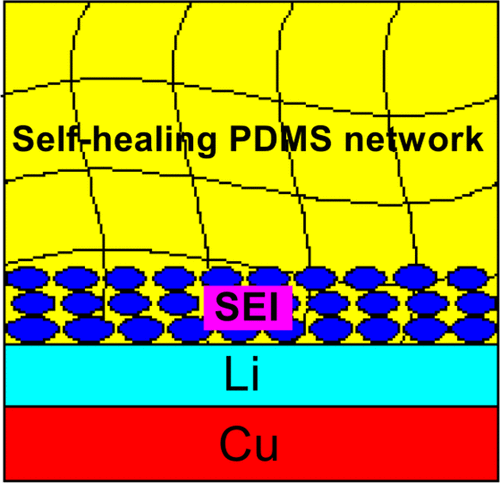当前位置:
X-MOL 学术
›
ACS Sustain. Chem. Eng.
›
论文详情
Our official English website, www.x-mol.net, welcomes your
feedback! (Note: you will need to create a separate account there.)
Stabilizing Li Metal Anodes through a Novel Self-Healing Strategy
ACS Sustainable Chemistry & Engineering ( IF 7.1 ) Pub Date : 2018-07-05 00:00:00 , DOI: 10.1021/acssuschemeng.8b02564 Ximing Cui 1 , Ying Chu 1 , Liming Qin 1 , Qinmin Pan 1
ACS Sustainable Chemistry & Engineering ( IF 7.1 ) Pub Date : 2018-07-05 00:00:00 , DOI: 10.1021/acssuschemeng.8b02564 Ximing Cui 1 , Ying Chu 1 , Liming Qin 1 , Qinmin Pan 1
Affiliation

|
Poor stability is a long-standing problem preventing the practical application of Li metal anodes, which is fundamentally attributed to their fragile solid electrolyte interphase (SEI) layers that are intrinsically neither adaptable to the dynamic volume change nor self-healable after breakage. Here a Li metal anode is effectively stabilized by in situ integrating its SEI layer into a self-healable polydimethylsiloxane (PDMS) network cross-linked via imine bonding. The self-healing network enables the integrated SEI layer to readily accommodate the volume change but also to repair itself after breaking. Consequently, the resulting anode exhibits excellent cycling stability and a dendrite-free morphology. In a Li/LiFePO4 full cell, this strategy leads to capacity retention up to 99% and a Coulombic efficiency >99.5% after 300 cycles. Our investigation provides a novel self-healing strategy for developing stable Li-metal anodes aiming at high energy-density batteries.
中文翻译:

通过一种新型的自愈策略稳定锂金属阳极
稳定性差是阻止锂金属阳极实际应用的长期存在的问题,这从根本上归因于其易碎的固体电解质中间相(SEI)层,该层本质上既不适应动态体积变化,也不能在断裂后自愈。在这里,通过将其SEI层原位集成到通过亚胺键交联的可自我修复的聚二甲基硅氧烷(PDMS)网络中,可以有效地稳定锂金属阳极。自我修复网络使集成的SEI层能够轻松适应体积变化,但在断裂后也能自我修复。因此,所得阳极表现出优异的循环稳定性和无枝晶形态。在Li / LiFePO 4中在整个电池单元中,此策略可导致容量保持率高达99%,并且300个循环后库仑效率> 99.5%。我们的研究为开发针对高能量密度电池的稳定锂金属阳极提供了一种新颖的自我修复策略。
更新日期:2018-07-05
中文翻译:

通过一种新型的自愈策略稳定锂金属阳极
稳定性差是阻止锂金属阳极实际应用的长期存在的问题,这从根本上归因于其易碎的固体电解质中间相(SEI)层,该层本质上既不适应动态体积变化,也不能在断裂后自愈。在这里,通过将其SEI层原位集成到通过亚胺键交联的可自我修复的聚二甲基硅氧烷(PDMS)网络中,可以有效地稳定锂金属阳极。自我修复网络使集成的SEI层能够轻松适应体积变化,但在断裂后也能自我修复。因此,所得阳极表现出优异的循环稳定性和无枝晶形态。在Li / LiFePO 4中在整个电池单元中,此策略可导致容量保持率高达99%,并且300个循环后库仑效率> 99.5%。我们的研究为开发针对高能量密度电池的稳定锂金属阳极提供了一种新颖的自我修复策略。









































 京公网安备 11010802027423号
京公网安备 11010802027423号